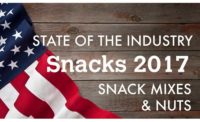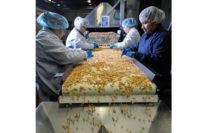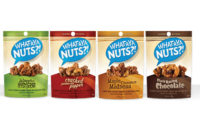Opened in 2007, the massive nut and snack processing facility at John B. Sanfilippo & Son Inc.’s (JBSS) headquarters in Elgin, Ill., proves that the company, which opened 92 years ago in Chicago, is committed to being a global leader of innovative nut products. We recently visited the company, which also sells trail mix, snack sticks and other snacks under the Fisher, Orchard Valley Harvest, Flavor Tree and Sunshine Country brands.
Relocated from Elk Grove Village, Ill., JBSS’s spacious Elgin facility incorporates an attractive office center, a retail shop, a vast production, distribution and warehousing space and a few open areas for additional expansion. “We process all kinds of peanuts, which are consumed each year in the U.S. at a rate topping 1.3 million tons (in-shell),” explains Howard Brandeisky, the company’s senior vice president of global marketing and customer solutions.
Nuts, he adds, are a smart snack. “One handful can contain the vital nutrients you need to stay energized all day long,” he says. “The health benefits of nuts are undeniable. So we’re nuts for nuts, and that’s not such a bad thing. They have protein, fiber and fats, so they provide a filling feeling.”
The plant in Elgin has about 1 million sq. ft. of operating space, yet size isn’t the only indicator of JBSS’s near nationwide dominance in the nut market: The biggest strategic advantage it has over its competitors is the fact that it’s a vertically integrated supplier of key domestically grown nut varieties such as Virginia peanuts, runner-type peanuts, walnuts and pecans.
“For these nut types, we handle every detail of procurement, production and processing, starting with field representatives who consult and work with select farmers and growers,” states Jeffrey Sanfilippo, chairman of the board. To ensure freshness, once the nuts are purchased, the company transports them to one of its facilities closest to the supply source, he explains.
Production flows in a straight line from raw materials receiving to final packout. “In our product flow, we separate raw goods from processed goods; everything is kept separate,” plant manager Michael Norsen points out. “We start with incoming bulk nuts and then move to the mixing area and other processing sections. We don’t do any shelling at this facility; we only work with nut meats here. Of course, not every product is a mixture of different nuts, so many products bypass this area.”
All of the packed loads go into a specific finished-goods warehouse, which further prevents any cross contamination of raw and processed product. “No other company offers the same depth of involvement, diligent pursuit of quality or attention to detail,” notes Jeffrey Sanfilippo.
That’s a lot of peanuts
Fifty-seven packaging lines and 85 processing lines generate an amazing 220 million lb. of finished products each year. “That means, there is a lot of scheduling of work in process or WIP,” Norsen explains. The proprietary processing technology ensures a clean, high-quality product. And the company is certified at Level 2 by the Safe Quality Food Institute for its food-safety practices. “We work hard at keeping everything clean,” he says.
“The FDA [Food and Drug Administration] is currently reviewing the nut industry to determine what level of food safety risk it poses,” says Jasper Sanfilippo, president and COO. “Depending on the outcome of the FDA review, additional [food-safety] equipment could be necessary.”
The plant runs two 10-hour shifts, four to five days a week, depending on the season. Overall, there are just less than 2,000 stock-keeping units (SKUs), Norsen observes. With issues of food allergies being so important today, the company color codes every batch and container of product as well as incoming raw nut meats, to ensure that all varieties are clearly identified. “We process all kinds of nuts, from cashews to almonds, walnuts, peanuts, chestnuts, filberts, hazel nuts, pistachios—you name it,” he says. “The color codes assist us with all of the allergen controls we have, and the colors are prominently posted throughout the facility. If the container is coded green, for example, that means it’s a tree nut and if it’s red, it contains peanuts, so the coded items are never intermingled.”
A ‘mixed bag’
Processing starts after the nuts are cleaned and aspirated (a step in which air is vacuumed out to remove dust and other contaminants). If required, the nuts then head to the mixing area. Otherwise, they’re usually fed overhead from a bulk storage container on a mezzanine level into a hopper. “Of course, not every SKU is a mix of nuts, so many of the nuts bypass this area,” Norsen says.
From the hopper, the nuts drop onto a conveyor belt leading to the infeed of one of several roasters. Roasting temperatures are proprietary. In the large roasting area, there are three dry roasters and 13 oil roasters. Only certain types of oils are used, such as cottonseed, peanut and sunflower, none of which contain trans-fats.
After roasting, the nuts then drain and cool on a conveyor before they’re inspected and fed in bulk into bag-lined boxes. “Everything that goes to packoff is inspected for burns, contaminants and any foreign materials of any type,” Norsen explains. “At this point, we make sure that anything we send on to packaging is top quality.”
There are a number of different ways that the products can be mixed. “We use state-of-the- art, computer-controlled mixing systems that weighed out each product in the mix,” Norsen says. One system incorporates seven vibratory conveying hoppers that can each dispense a different type of nut into a conveyor pan. At the time of SF&WB’s visit, six of the hoppers were dispensing a different nut.
The mixing system is specifically designed to be as gentle as possible, Norsen tells SF&WB. “We run nuts, coated caramel balls, chocolates and other items on this line and don’t have any breakage,” he says. “There are some products we have to mix by hand such as trail mixes with large banana chips and such, but this system doesn’t chip the shells of coated chocolate candies and provides a tremendous way to mix product so that we consistently deliver the best quality particulate integrity that we can.”
The nuts can go through further WIP steps, which means that they can be seasoned, coated or undergo any number of other treatments, or they can be portion-packed in small bags.
On the specialized mixing system, the mixed nuts then convey down the vibratory conveyor to a bucket elevator that takes them to the infeed of a weigh scale and then they’re packaged in bags. “This is a high-speed packaging line,” Norsen says. “In the time we have been discussing it, the product has gone from raw goods to finished packages at considerable speeds. We have some lines that run more than 100 cans or bags a minute.”
Plenty of package configurations
The packaging lines work with assorted container configurations, including transparent plastic cans, standup pouches with resealable zipper closures, layflat bags, tall jars, composite cans, multipack bags and more. During our visit, one packaging line was running the company’s latest introduction, a multipack standup bag for Orchard Valley Harvest nut mixes that holds eight 1-oz. portion-packed bags. Computerized controls monitor the lines’ operating parameters, such as speeds and sealing temperatures.
“This [package] gives consumers a nice portion in a generously sized multipack standup bag with a zipper,” Brandeisky says. “It’s very convenient, and consumers want convenience. Consumers are interested in healthy snacking, and perceive nuts and nut mixes as healthy. And the portion-packs will expand distribution of the Orchard Valley Harvest brand. We’re very proud of it. Standup bags are a simple idea, and we increased our standup bag capacity because consumers and retailers like them so much.”
Purchased in 2010, the Orchard Valley Harvest line includes nuts, trail mix, dried fruit and chocolate-covered nuts, formulated with no artificial ingredients, Brandeisky explains. “We make that claim right on the package and are in the process of getting them certified as nonGMO [non-genetically modified organisms],” he says. “We did a lot of consumer research about the products, and we relaunched the brand. The packaging is new and the product profile is better defined against the needs of the produce consumer. The brand is really targeting the produce/nut section of the grocery store. The nut category overall has been growing, but it’s really been growing in the produce section.”
Elsewhere, a barrage of horizontal form/fill/seal (hf/f/s ) systems produce standup bags for nut mixes. As metalized bag film rolls unwind into the machines on one end, bags are heat-sealed with a resealable zipper feature on the other end. Metal detectors on the f/f/s systems do their jobs, as the finished bags single-file down a conveyor and are checkweighed and inspected before they’re coded and manually case-packed.
The corrugated shipping cases are tape sealed automatically and palletized by hand. The palletized loads are then forklifted to a stretch-wrapping area and moved to a large finished-goods warehouse.
In addition, many of the products are nitrogen-flushed during packaging to remove oxygen in what’s called a modified atmosphere packaging (MAP) process that helps extend shelf life. The shelf life of most of the products is between 12 and 18 months. “We recommend storing all roasted nuts in a cool place,” Brandeisky says. “Ideally, the refrigerator is the best option for storing open product. Raw nuts can last up to one year if they’re stored in the freezer.”
In fact, a line running Fisher cocktail nuts MAP-packages them for freshness in clear plastic cans with foil seals and plastic overlids. “We developed these clear plastic cans in 2010,” Brandeisky says. “As far as we know, we’re the first company to use a clear plastic can for nuts. Consumers love seeing the quality of the product [through the can]. They love the transparency, and it’s recyclable and reusable.”
Meanwhile, several standup bag lines form and fill bags, then heat-seal the tops and apply resealable zippers. “The standup bag is very popular,” Norsen notes. “We’re installing another line for standup bags and have four smaller systems over there for standup bags.”
The plant also uses Hazard Analysis and Critical Control Points (HACCP), and line operators make sure that everything produced is in accordance with HACCP. JBSS also implemented the LEAN manufacturing practice in both the manufacturing plants and offices. “We think this approach can help us reduce waste, improve quality and reduce costs,” says Jeffrey Sanfilippo.
Norsen says that equipment and processes are constantly being upgraded. “We’re constantly automating,” he adds.
Future plans
What’s next? Jeffrey Sanfilippo says that the company will continue to execute its core strategies to build the Fisher and Orchard Valley Harvest brands as well as expand globally, especially in growth markets such as China. And who knows? With nuts being such a popular snack, the sky’s the limit for JBSS.










